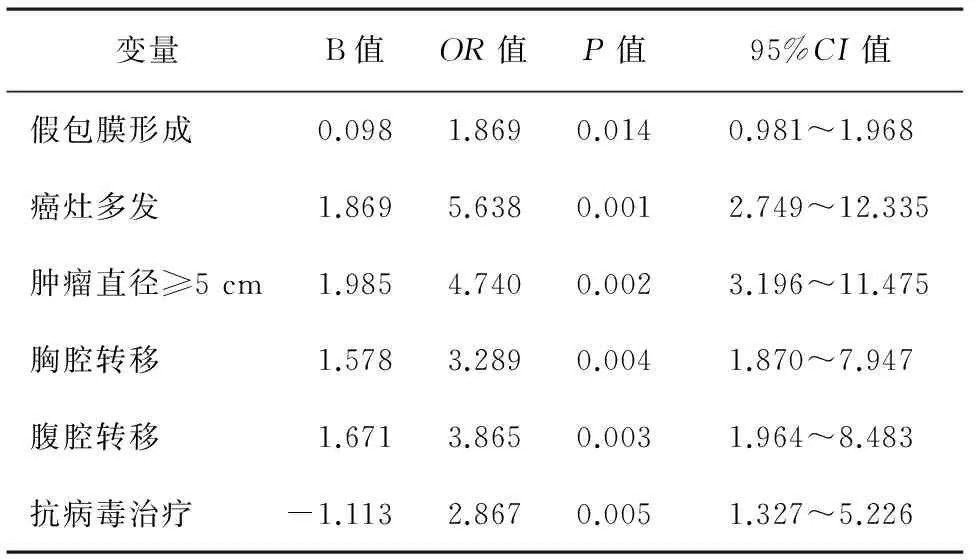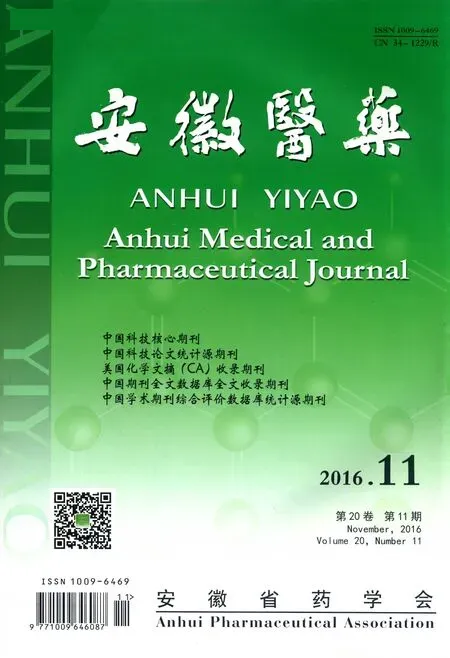肝動脈化療栓塞治療乙型肝炎相關性肝癌的預后影響
汪艷,陳樂
(黃岡市中心醫院感染科,湖北 黃岡 438000)
?
肝動脈化療栓塞治療乙型肝炎相關性肝癌的預后影響
汪艷,陳樂
(黃岡市中心醫院感染科,湖北 黃岡 438000)
目的 探討肝動脈化療栓塞治療乙型肝炎相關性肝癌的預后影響因素。方法 對行肝動脈化療栓塞治療的150例患者臨床資料進行回顧性分析,觀察肝動脈化療栓塞治療3年后患者生存率,并對肝動脈化療栓塞治療乙型肝炎相關性肝癌的預后影響因素采用單因素分析及Logistic多因素分析。 結果 (1)150例乙型肝炎相關性肝癌患者經肝動脈化療栓塞治療3年后,存活64例,死亡86例, 3年生存率為42.67%,死亡率為57.33%。(2)單因素分析得出:假包膜形成、癌灶數目多、門脈癌栓、腫瘤直徑大、胸腔轉移、腹腔轉移均為肝動脈化療栓塞治療乙型肝炎相關性肝癌的危險因素為肝動脈化療栓塞治療乙型肝炎相關性肝癌的保護因素,均差異有統計學意義(P<0.05)。(3)經Logistic多因素回歸分析得出:假包膜形成、癌灶多發、門脈癌栓、腫瘤直徑≥5 cm、胸腔轉移、腹腔轉移均為肝動脈化療栓塞治療乙型肝炎相關性肝癌的危險因素。結論 假包膜形成、癌灶多發、門脈癌栓、腫瘤直徑≥5 cm、胸腔轉移、腹腔轉移均為肝動脈化療栓塞治療乙型肝炎相關性肝癌的危險因素。
乙型肝炎相關性肝癌;肝動脈化療栓塞治療;危險因素
乙型肝炎相關性肝癌病情進展迅速,但起病具有隱匿性,因此一旦確診絕大多數患者已出現胸腹部等遠處轉移情況,從而使得無法手術治療,失去最佳治療時機,預后差[1]。目前,乙型肝炎相關性肝癌的主要治療方法為肝動脈化療栓塞,已被臨床廣泛應用[2]。近年來,如何更好的治療乙型肝炎相關性肝癌已逐漸成為臨床醫生研究的熱點[3]。為此筆者回顧性分析行肝動脈化療栓塞治療的150例患者臨床資料,現將結果報告如下。
1 資料與方法
1.1 臨床資料 回顧性分析2010年2月至2012年10月在黃岡市中心醫院進行肝動脈化療栓塞治療的150例患者臨床資料,其中男性83例,女性67例;年齡16~81歲,平均(46.97±11.22)歲;其中癌灶單發者99例,癌灶多發者51例;假包膜形成者54例,無假包膜形成者96例;存在門脈癌栓者39例,未見門脈癌栓者111例。本研究獲得黃岡市中心醫院倫理委員會批準,患者或近親屬簽署了知情同意書。
1.2 方法
1.2.1 肝動脈化療栓塞治療 選擇Seldinger 技術進行肝腸系膜上動脈與總動脈常規造影術,觀察門靜脈充盈狀態及肝臟內部腫瘤供血狀況。采用夾心式進行局部化療栓塞,注入羥基喜樹堿、氟脲嘧啶、絲裂霉素、表阿霉素及順鉑等藥物。藥物劑量根據肝功能情況、腫瘤分布及腫瘤大小而定。
1.2.2 隨訪 全部患者均建立詳細的資料檔案,出院后通過電話、郵件、登門等方式定時進行隨訪。
1.3 觀察指標 (1)觀察肝動脈化療栓塞治療3年后患者生存率;(2)單因素分析肝動脈化療栓塞治療乙型肝炎相關性肝癌的預后相關因素,其中包括年齡、性別、假包膜形成、癌灶數目、門脈癌栓、腫瘤大小、胸腔轉移、腹腔轉移及化療次數;(3)經Logistic多因素回歸分析肝動脈化療栓塞治療乙型肝炎相關性肝癌的預后相關因素。

2 結果
2.1 肝動脈化療栓塞治療3年后患者生存率 150例乙型肝炎相關性肝癌患者經肝動脈化療栓塞治療3年后,存活64例,死亡86例, 3年生存率為42.67%,死亡率為57.33%。
2.2 單因素分析肝動脈化療栓塞治療乙型肝炎相關性肝癌的預后相關因素 單因素分析得出:假包膜形成、癌灶數目多、門脈癌栓、腫瘤直徑大、胸腔轉移、腹腔轉移均為肝動脈化療栓塞治療乙型肝炎相關性肝癌的危險因素(P<0.05),見表1。

表1 單因素分析肝動脈化療栓塞治療乙型肝炎相關性肝癌的預后相關因素/例
2.3 Logistic多因素分析肝動脈化療栓塞治療乙型肝炎相關性肝癌的預后相關因素 經Logistic多因素回歸分析得出:假包膜形成、癌灶多發、門脈癌栓、腫瘤直徑≥5 cm、胸腔轉移、腹腔轉移均為肝動脈化療栓塞治療乙型肝炎相關性肝癌的危險因素,見表2。

表2 Logistic多因素分析肝動脈化療栓塞治療乙型肝炎相關性肝癌的預后相關因素
3 討論
原發性肝癌屬于我國臨床上常見的惡性腫瘤,該病進展迅速,起病隱匿,一旦確診絕大多數患者已出現遠處轉移,從而失去手術最佳治療時機[4-9]。目前,作為不能進行手術切除以及手術復發者,肝動脈化療栓塞治療能否有效改善乙型肝炎相關性肝癌患者的預后仍存在爭議[10]。有相關研究[11-13]顯示,進行肝動脈化療栓塞治療的乙型肝炎相關性肝癌患者的中位生存時間明顯高于保守治療患者。但亦有相關研究[14]顯示,雖然肝動脈化療栓塞治療能夠抑制腫瘤生長,但對于提高患者生存率未見顯著效果。本研究結果顯示,150例乙型肝炎相關性肝癌患者經肝動脈化療栓塞治療3年后,存活64例,死亡86例, 3年生存率為42.67%,死亡率為57.33%。
經本研究結果顯示并總結肝動脈化療栓塞治療乙型肝炎相關性肝癌的預后影響因素,具體如下:(1)假包膜形成:假包膜形成者的3年生存率為24.07%,顯著低于未見假包膜形成者的53.13%,差異有統計學意義(P<0.05),此結果表明,存在假包膜不利于肝動脈化療栓塞治療乙型肝炎相關性肝癌的預后;(2)癌灶數目:通過對比癌灶單發與多發情況得出,癌灶多發者3年生存率為21.57%,顯著低于癌灶單發者的53.54%,比較差異有統計學意義(P<0.05),癌灶多發嚴重影響乙型肝炎相關性肝癌的預后;(3)腫瘤直徑:腫瘤越大,肝動脈化療栓塞治療的預后越差,乙型肝炎相關性肝癌的3年生存率越低;(4)胸腹腔轉移:若出現胸腔或腹腔轉移,腫瘤則更難控制,嚴重治療預后,生存率顯著降低。
綜上所述,假包膜形成、癌灶多發、門脈癌栓、腫瘤直徑≥5 cm、胸腔轉移、腹腔轉移均為肝動脈化療栓塞治療乙型肝炎相關性肝癌的危險因素。
[1] Zhou ZG,Zheng XR,Zhou Q,et al.Impact of oral anti-hepatitis B therapy on the survival of patients with hepatocellular carcinoma initially treated with chemoembolization[J].Cancer,2015,33(5):205-216.
[2] Chen XH,Heng B.Risk factors for residual tumor after resection of hepatocellular carcinoma[J].World Journal of Gastroenterology,2011,17(14):1889-1894.
[3] Lance C,McLennan G,Obuchowski N,et al.Comparative analysis of the safety and efficacy of transcatheter arterial chemoembolization and yttrium-90 radioembolization in patients with unresectable hepatocellular carcinoma[J].JVIR,2011,22(12):1697-1705.
[4] Group KL.2014 Korean Liver Cancer Study Group-National Cancer Center Korea Practice Guideline for the Management of Hepatocellular Carcinoma[J].Korean Journal of Radiology,2015,16(3):465-522.
[5] Toyoda H,Kumada T,Tada T,et al.Transarterial chemoembolization for hepatitis B virus-associated hepatocellular carcinoma:improved survival after concomitant treatment with nucleoside analogues[J].J Vasc Interv Radiol,2012,23(3):317-322.
[6] 蔡軼倫,張慶紅,姚詠明.肝癌患者術后手術部位感染的危險因素分析[J].中華醫院感染學雜志,2013,23(23):5724-5726.
[7] Yan Q,Ni J,Zhang GL,et al.Efficacy of postoperative antiviral combined transcatheter arterial chemoembolization therapy in prevention of hepatitis B-related hepatocellular carcinoma recurrence[J].Chinese Medical Journal,2013,126(5):855-859.
[8] Nishikawa H,Osaki Y,Inuzuka T.Branched-chain amino acid treatment before transcatheter arterial chemoembolization for hepatocellular carcinoma[J].World Journal of Gastroenterology,2012,18(12):56-59.
[9] Jiang JH,Guo Z,Lu HF,et al.Adjuvant transarterial chemoembolization after curative resection of hepatocellular carcinoma:Propensity score analysis[J].World Journal of Gastroenterology Wjg,2015,21(15):4627-4634.
[10] Chau GY.Resection of hepatitis B virus-related hepatocellular carcinoma:Evolving strategies and emerging therapies to improve outcome[J].World Journal of Gastroenterology,2014,20(35):12473-12484.
[11] Yu SJ,Kim YJ.Hepatitis B viral load affects prognosis of hepatocellular carcinoma[J].World J Gastroenterol,2014,20(34):12039-12044.
[12] Lao,XM,Luo G,Ye LT,et al.Effects of antiviral therapy on hepatitis B virus reactivation and liver function after resection or chemoembolization for hepatocellular carcinoma[J].Liver International,2013,33(4):595-604.
[13] Hai Q,Wang J.Liver resection in hepatitis B related-hepatocellular carcinoma:Clinical outcomes and safety in elderly patients[J].World Journal of Gastroenterology,2014,20(21):6620-6625.
[14] Zhiping H,Peng Z,Haiqing W,et al.Comparing outcomes of two vascular inflow occlusion techniques and treatment without vascular occlusion during major hepatectomy in patients with Hepatitis B-related hepatocellular carcinoma[J].Plos One,2014,9(9):e107303.
Prognostic impact of transcatheter arterial chemoembolization in the treatment of hepatitis B associated hepatocellular carcinoma
WANG Yan,CHEN Le
(DepartmentofInfectiousDiseases,HuanggangCentralHospital,Huanggang,Hubei438000,China)
Objective To investigate the prognostic factors of hepatic artery chemoembolization in the treatment of hepatitis B associated hepatocellular carcinoma.Methods Clinical data of 150 cases undergoing hepatic artery chemotherapy embolization were retrospectively analyzed.Three-year survival rate of the patients was observed,and prognostic influence factors were analyzed using single factor analysis and Logistic multivariate regression analysis.Results Three years after the treatment,of 150 cases of HBV related hepatocellular carcinoma patients,64(42.67%)cases survived,and 86(57.33%)cases died.The single factor analysis showed that pseudocapsule formation,tumor number,tumor thrombus in the portal vein,diameter of tumor,pleural and peritoneal metastases were risk factors of hepatic artery chemoembolization in the treatment of hepatitis B virus associated hepatocellular carcinoma.The differences were statistically significant(P<0.05).The Logistic multivariate regression analysis showed that pseudocapsule formation,cancer lesions,portal vein tumor thrombus,tumor diameter greater than 5 cm,pleural and peritoneal metastases were risk factors of hepatic arterial chemoembolization in the treatment of hepatitis B virus associated hepatocellular carcinoma.Conclusions Formation of pseudocapsule,multiple tumor,portal vein tumor thrombus,tumor diameter greater than or equal to 5 cm,pleural metastasis,and peritoneal metastasis are risk factors of transcatheter arterial chemoembolization in the treatment of hepatitis B virus related hepatocellular carcinoma(HCC).
Hepatitis B related hepatocellular carcinoma;Transcatheter arterial chemoembolization;Risk factor
10.3969/j.issn.1009-6469.2016.11.046
2016-04-12,
2016-08-23)

